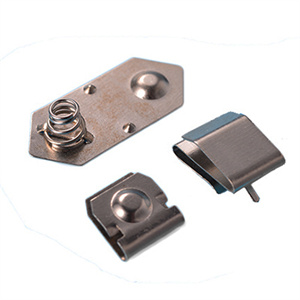The Leaf Shape Battery Contact Spring offers the following features and advantages:
Good elastic deformation capacity: the blade shape design can provide uniform and moderate elasticity, ensure that the battery always maintains a stable contact pressure during installation and use, and effectively prevent poor contact.
Low resistance characteristics: help to reduce the energy loss in the transmission process of current and improve the discharge efficiency and charging speed of the battery.
Fatigue resistance: Capable of withstanding frequent compression and extension, not prone to elastic failure in long-term use, and prolonging the service life of battery contact spring.
Compact structure: the blade design occupies less space and is applicable to the battery installation environment with limited space.
In practical application:
For example, in small portable electronic devices such as bluetooth headphones, leaf-shaped battery contact springs provide reliable electrical connection in a confined space.
In the battery module of the smart watch, it can ensure the stable contact between the battery and the device without affecting the thin design of the device.
However, leaf cell contact springs have some limitations:
High manufacturing accuracy: complex blade structure requires high-precision manufacturing process and equipment, which increases the production cost.
Relatively difficult to install: due to its special shape, it requires more careful and accurate operation during installation.
Battery contact shrapnel belongs to the category of metal stamping and electronic hardware materials, and is an important part of the battery. It is made of copper, iron, stainless steel and other materials, electroplating CT, silver, nickel, etc. Battery shrapnel is widely used in various electronic devices due to its excellent elastic properties and physical properties.
The types of battery contact / shrapnel are mainly classified according to their shape, size, material, and application. For example, it can be divided into round, square, special-shaped, etc., according to the size, it can be divided into large, medium, small, etc., and according to the material, it can be divided into copper, iron, stainless steel, etc. In addition, there are some special-purpose battery shrapnel, such as highly elastic battery shrapnel, high conductivity battery contact / shrapnel, etc.
The specific type and model of battery contact need to be selected according to different use scenarios and equipment requirements. When selecting battery shrapnel, it is necessary to consider its conductivity, elasticity, corrosion resistance, wear resistance and other factors to ensure the stability and safety of the battery.
